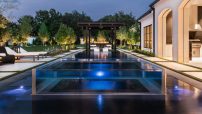Back in college, Franceen Gonzales focused on saving lives: as a waterpark lifeguard and also as a pre-med student preparing.
Though she hung up her whistle years ago and traded in her medical aspirations for a career in aquatics, her focus remains on safety — whether related to swimming ability, water quality, air quality or product safety.
“Safety is ubiquitous,” says the chair-elect for the Pool and Hot Tub Alliance and executive vice president of business development for WhiteWater West, a manufacturer of waterpark equipment based in Richmond, British Columbia, Canada. “It doesn’t matter if it’s residential or commercial. It’s about safety and making sure people are having a good time in the water.”
Greater good
The change in career trajectory came when Gonzales was offered a full-time position at the waterpark where she worked as she prepared to take the Medical College Admission Test (MCAT).
When she first set foot into the World Waterpark Association (WWA) trade show, she was amazed by its possibilities. “I realized I could build a career out of it,” she says.
She began managing various waterparks and family amusement parks. In the middle of this, an insurance crisis started. Waterparks were having a difficult time securing insurance, and she had to prove to a provider that her park, Golfland Family Entertainment in Arizona, was operated safely, and that she and her staff were good at ensuring safety.
Soon, she was managing risk for all of Golfland Family Entertainment’s parks, then running operations at Six Flags Hurricane Harbor in New Jersey, then opening several resorts for Great Wolf Lodge. During the recession, she found herself “wearing a lot of different hats — maintenance, engineering and safety.”
While at Great Wolf Lodge, she had to handle a health situation. Guests were getting sick from exposure to chloramines — the combination of chlorine and ammonia dispelled by perspiration, urine, and other biologic products — despite the resort’s careful maintenance and brand-new equipment. She and her staff worked closely with state and federal officials to fix the situation and prevent future problems, an experience that served her well as chair of the Ventilation Technical Committee for the Model Aquatic Health Code project.
Since 2013, she’s been working for WhiteWater West on the supply side, helping take care of clients and applying her operations and business modeling background. She says she lives “out of a suitcase,” but when she is home in Indian Rock Beach, Fla., you can find her relaxing in her backyard pool.
She’s also served on several association boards. For the Model Aquatic Health Code, she helped set air quality standards for indoor aquatics facilities. As member of ASTM International Board of Directors, she drafts standards for various waterpark equipment, such as water slides and water play structures. She also served on the safety committee for the International Association of Amusement Parks and Attractions (IAAPA) and on the board of director for AIMS International, an organization directed at amusement park safety. She previously served as chair of the WWA, and today is preparing to chair the PHTA.
Through PHTA, she’s looking to enhance the educational platforms, which she says already have a lot of depth and breadth in both residential and commercial sides to accommodate varying experience levels.
She also wants to encourage swimming as an activity. She recalls a time when waterparks had deep water, which created a higher risk of drowning. But she says that in implementing shallow-only pools, the industry has “created this place you can enjoy but you don’t have to learn to swim. I want both.”
She calls this the “spiritual purpose” of PHTA to create more swimmers. “More swimmers mean people aren’t afraid of the water,” she explains.
Another of her goals is to increase people’s access to pools and hot tubs — whether in people’s backyards, apartment complexes or communities — and with it, more swimming lessons through scholarships. “PHTA is trying to foster people wanting to have a pool, celebrating the water and having a respect for it,” she says.
She particularly hopes to focus on underprivileged groups who can’t afford swimming lessons or may not have easy access to a pool.
Part of this increase in access comes by inspiring people to design beautiful pools and hot tubs, and creating “outdoor living rooms” for people to enjoy, she says.
“We all have an interest in keeping the swimming pool business vibrant,” she says. “I’m a big supporter of making pools and hot tubs not just a trend, but a part of every household.”
In addition to creating safety in swimming pools by teaching people how to swim, she also wants to continue that safety through lifestyle and exercise.
“We cannot ignore the health benefits of swimming and enjoying the water,” she says. “The neuroscience shows the calming effect of water and the results of this activity one’s overall well-being.”


